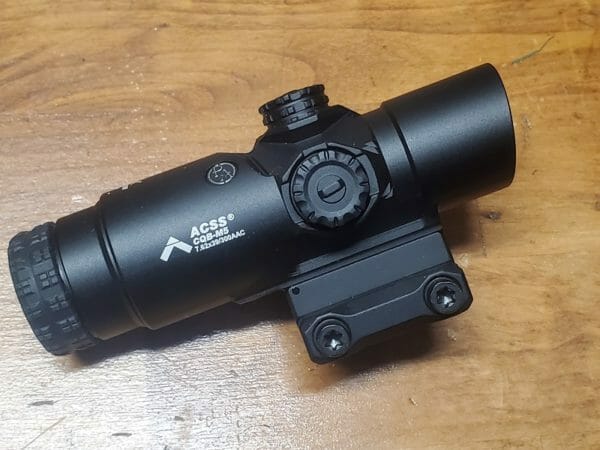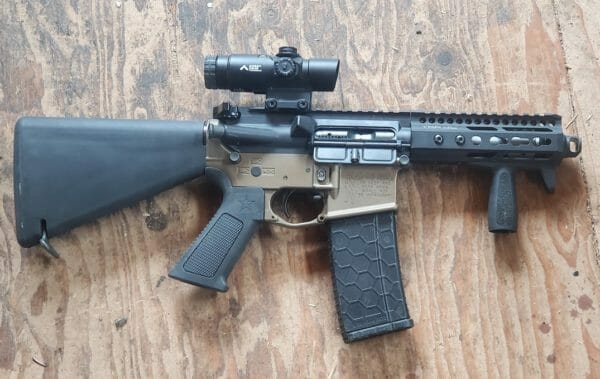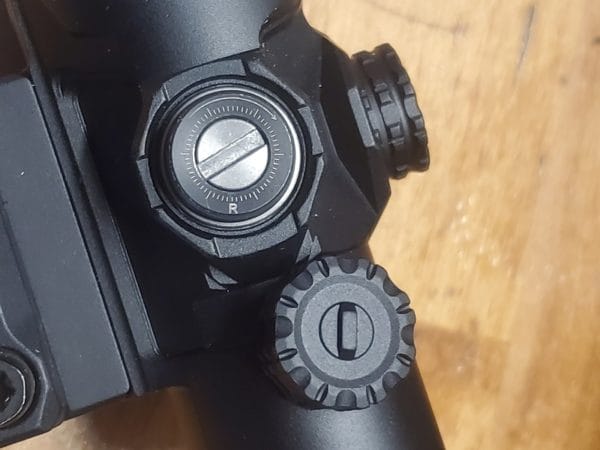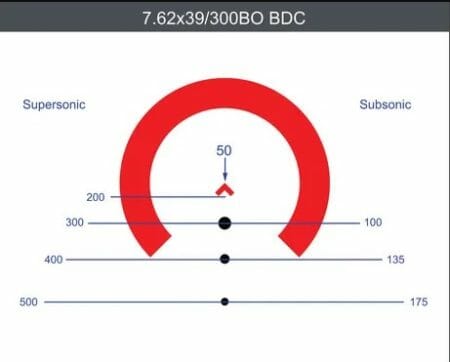
U.S.A. –-(AmmoLand.com)- I don’t envy the task that optics manufacturers have in front of them. We, as shooters, want the best glass, longest battery life, widest field of view, light weight, durability, and a competitive price ($369.99). All while preferably not being made in China. Some opt for a jack-of-all-trades low-power variable optic, while others prefer the bomb-proof simplicity of a fixed power prismatic optic. Given that I’m looking to replace some of my red dot optics as my 40th birthday approaches and my eyesight is starting to waver off the 20/20 mark, it seems natural to try out some optics that approach the speed with which one can acquire the target through a reflex sight, and the ease of target ID that some magnification provides. It is through this lens that I try out Primary Arms’ GLx 2x Prism with ACSS CQB-M5 762×39/.300 Blackout reticle.
Primary Arms GLx 2x Prism Optic

Let’s check the tale of the tape before covering hands-on usage. Specs provided by Primary Arms.
Tech Specs:
- Brand: Primary Arms
- MPN: 710012
- <SKU:PA-GLX-2XP-ACSS-7.62
- Battery Type: CR2032 3V Lithium Coin, 20,000 hours on middle setting
- Click Value: 1/4 MOA
- Eye Relief: 3.50 in
- Field View: @100, 42.00 ft
- Illumination: 11 Settings
- Magnification: 2X
- Night Vision Compatible: Yes, 2 NVG Settings
- Reticle: Glass Etched and Illuminated ACSS CQB-M5 7.62×39/.300 Blackout
- Total Elevation Adjustment: 40 MOA
- Total Windage Adjustment: 40 MOA
- Weight: 11.0 Oz.
- Compatible With Standard Mini-ACOG Style Mounts
- Protected By a Lifetime Warranty
- Eye Relief: 3.5″
- Features AUTOLIVE Motion Activation
It’s worth noting that this is a GLx product, indicating it’s from their Gold line, which is engineered in Texas and manufactured in the Philippines. The GLx line also shows up with more technological features than the lower tier SLx (silver) and CLx (classic) lineups, such as the Autolive “shake-and-wake” feature. The PLx (platinum) line is made in Japan.
This is my first foray into an optic with a feature like Autolive. I’ve been a slow adopter of this because of my natural tendency to distrust newer technological features in favor of the tried-and-true. I don’t want a new feature to end up draining my battery, leaving me high and dry when I need it most. Over the last few months, the GLx 2x’s Autolive has calmed my concerns, mostly because it isn’t overly sensitive. Before mounting the GLx 2x to a rifle, I left it on for a while sitting on my desk. After three minutes without movement, the reticle’s illumination cuts out. Slowly moving the optic doesn’t reignite the illumination, nor did lightly bumping the desktop. It took a moderately abrupt change of direction or lightly slapping the side of the optic to wake it. Certainly faster than fiddling with the illumination dial, but not so sensitive I can’t trust it. Sweet spot. It’s the same when it’s on my rifle. If I carefully maneuver the gun within my safe to get out a rifle closer to the back, the illumination stays off. If I pull the GLx-equipped rifle out in a hurry, it’s ready to go.
Mounting is done in typical Primary Arms fashion, with two large torx bolts clamping the optic to your firearm. Besides the mount that comes attached to the optic, two additional spacers are included in the box. One slightly higher, one slightly smaller than the preconfigured height. Having the GLx 2x be compatible with Mini-ACOG mounts is a deft move, meaning the aftermarket has already provided a variety of options should the end user want a different setup.
The windage and elevation caps have a small, but essential feature in my opinion. Tabbed notches on the outside flat, which are used to make the adjustments. No more digging around for a piece of brass, or using your pocketknife. The adjustments themselves are crisp, tactile, and audible. No mush or slop is evident.

Eleven ounces. As far as optics go, it’s really not much. Considering that the GLx 2x is only ~5 oz heavier than most “micro” red dot optics, yet provides much more. The glass etched and illuminated reticle for one, not only provides a bullet drop compensation (BDC) chart, but also a windage lead and ranging feature. Plus, if the battery does run dry, you still have a functioning optic. One aspect of using a BDC reticle however, is “truing” your data. Preconfigured bullet drop charts are based on one specific bullet, with one specific ballistic coefficient of friction, leaving the barrel at one specific velocity. Take your preferred hunting/defensive ammo, zero the optic, then shoot with that BDC reticle at the ranges listed and note the point of impact. Unless you’re using the exact same setup the BDC was calibrated for, there’s going to be a little variation.
Eye relief is listed at 3.5″, but in reality is far more forgiving than any other optic I’ve used, short of 1x RDO’s. Whether my eye is 1″ or 7″ away from the rear glass, it’s easy to line up the reticle on target. Since we’re on the subject of “eyes through the tube”, I want to say that both the clarity of the glass and the field of view through the GLx 2X are fantastic. I don’t say this lightly! 42 feet FOV at 100 yards is pretty excellent, especially given that it is not hard to shoot with both eyes open through this optic, using the Bindon Aiming Concept. Colors are bright, and the glass transmits light really well. Even when dusk is settling over my forested property, the GLx 2x does its best to keep the light flowing.
What about when night falls? It’s true that most night vision equipped shooters prefer IR lasers, and for good reason. But if you need to use your head mounted NVG’s to aim in conjunction with a rifle mounted optic, the GLx 2x works well. The exceptionally forgiving eye box really helps in this regards, making this a far less finnicky experience that with my 4x ACOG (which in itself, is still a very functional optic for this purpose).
I think most people’s use for the GLx 2x would be as a replacement for a 1x RDO. As such, I’m really not feeling behind the power curve when shooting CQB warmups. If I’m losing speed, it isn’t much, and will certainly be offset with some more time spend practicing with this optic. I’m definitely gaining speed when shooting out past 150 yards though.
I don’t do intentionally destructive testing with blowtorches, hammers and the like. I’m not gentle with review products either though. The GLx 2x has had no problems with the normal levels of use and abuse I’ve given it. Given how robust prism optics are in general, as well as the simplicity of fixed power optics, and Primary Arms’ reputation, I’m pretty confident in this GLx 2x’s durability going forward. If there’s a problem, I’ll update this article.

The ACSS series of reticles have won me over as a fan. The bullet drop compensation (BDC) on the GLx 2x gives a good (estimated) drop for your supersonic rounds out to 500 yards, and subsonic rounds out to 175 yards. As with any preconfigured BDC, it’s important to compare your real world data for the load you use, as it may deviate a bit from the rounds used to calibrate the BDC.

Normally when I like an optic, it finds its way into regular rotation on either a test gun (used for articles), or one of my “extras” that I shoot less often. The GLx 2x quickly headed to the top of one of my two most consistently used rifles. It runs well during the day, and it runs well at night. The horseshoe portion of the reticle grabs the eye quickly for close shooting, while the BDC is effective enough for ranged work. It turns on when you grab it, and stays off when you don’t. Bottom line: Primary Arms has put together a very competitive package at $369.99. If you’ve been wondering whether the GLx 2x is worth it, consider this one person’s hearty recommendation. Check it out!
About Rex Nanorum
Rex Nanorum is an Alaskan Expatriate living in Oregon with his wife and kids. Growing up on commercial fishing vessels, he found his next adventure with the 2nd Bn, 75th Ranger Regt. After 5 tours to Afghanistan and Iraq, he adventured about the west coast becoming a commercial fishery and salvage SCUBA diver, rated helicopter pilot instructor (CFII) and personal trainer, before becoming a gear reviewer and writer.”

